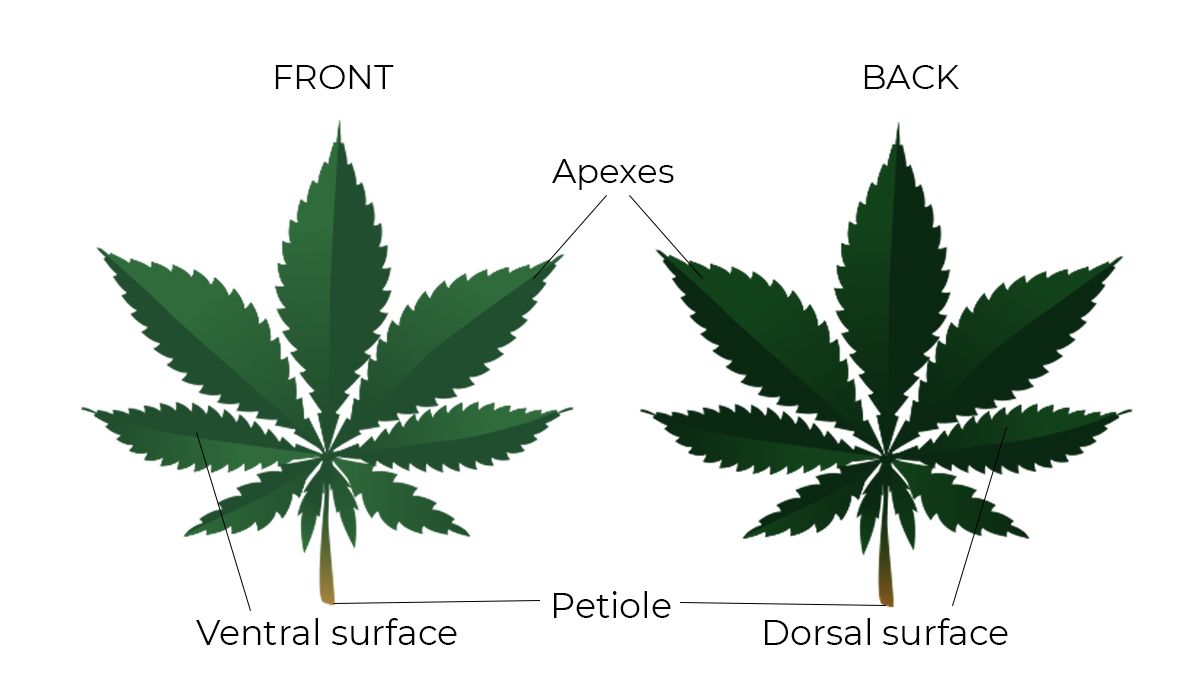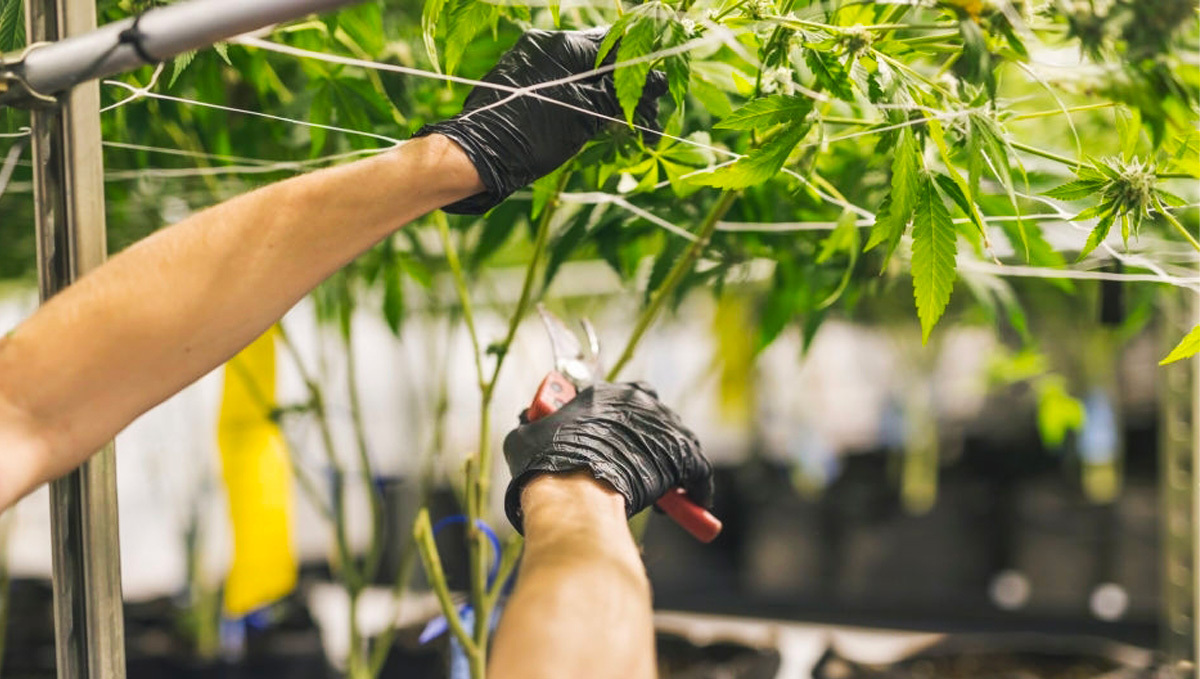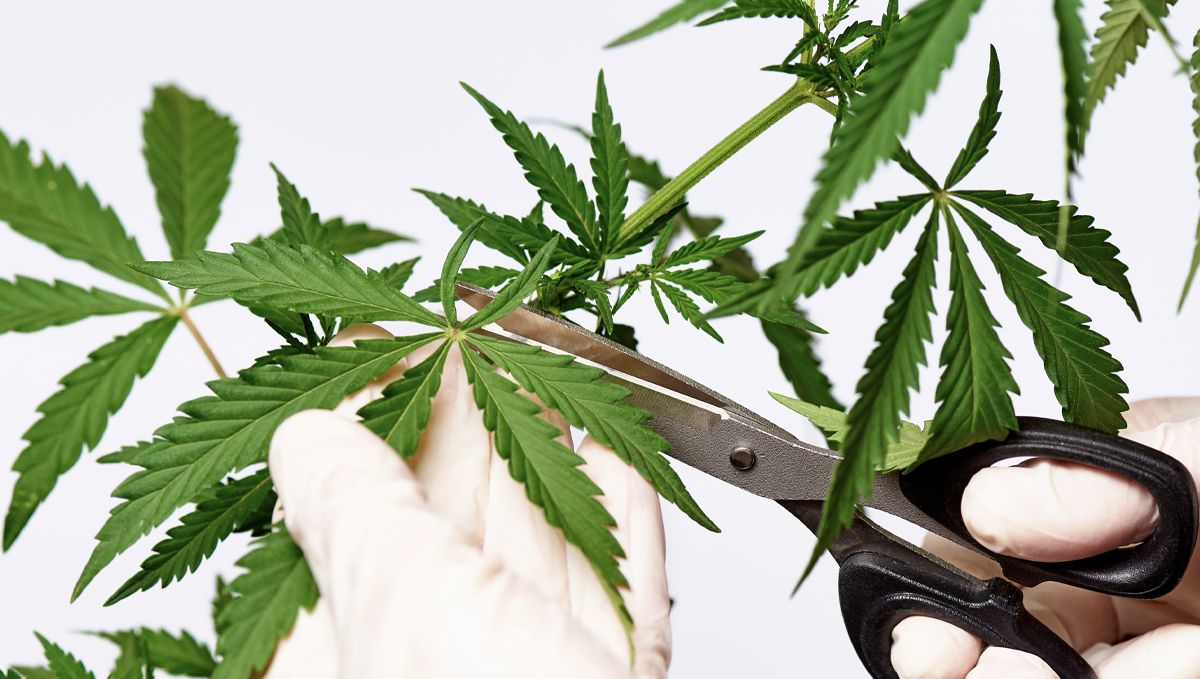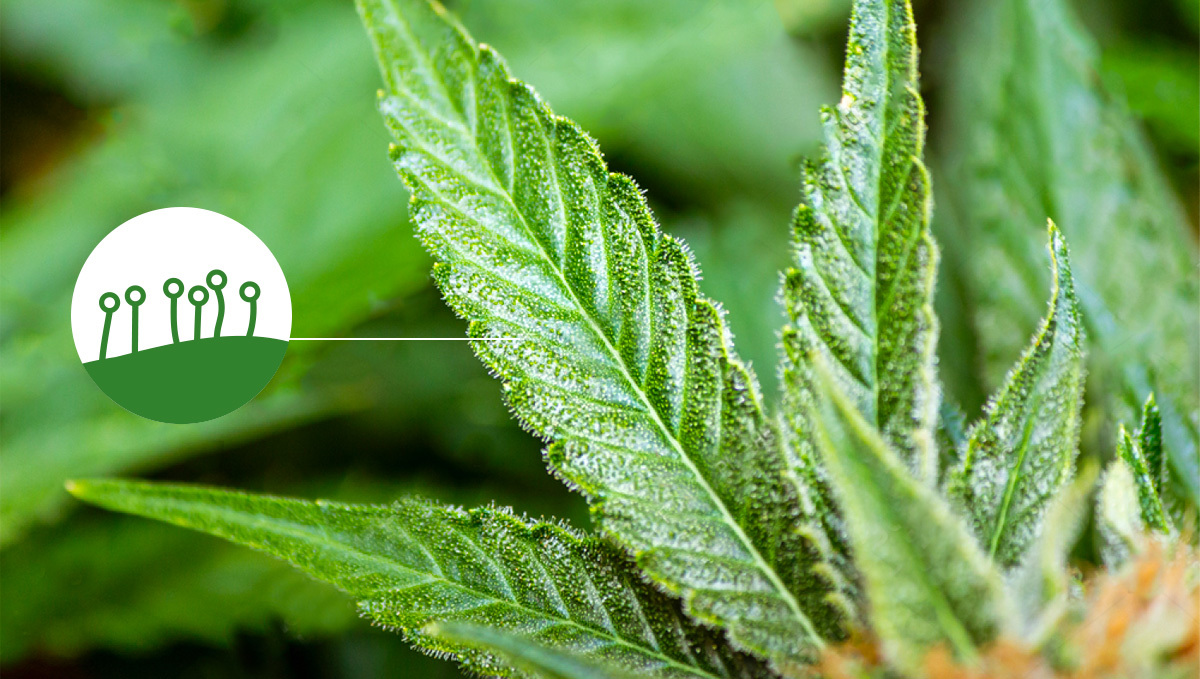Cannabis Leaf - When to Remove Cannabis Fan Leaves

- 1. What do fan leaves do?
- 2. Parts of a fan leaf
- 2. a. Petiole
- 2. b. Ventral surface
- 2. c. Dorsal surface
- 2. d. Apex
- 3. Do fan leaves contain cannabinoids?
- 4. When to remove fan leaves?
- 5. How to remove fan leaves
- 6. The different types of defoliation
- 6. a. Topping a cannabis plant
- 6. b. Lollipopping a cannabis plant
- 6. c. Mainlining a cannabis plant
- 6. d. Schwazzing a cannabis plant
- 7. Uses for the fan leaves
- 8. Cannabis defoliation faqs
- 9. In conclusion
Fan leaves are the typically fingered leaves in cannabis plants, they are the bigger leaves that stick out of the plant. And even though most growers don’t know it, they’re the most important organ of the plant. So...what are cannabis fan leaves?
1. What Do Fan Leaves Do?
All leaves on cannabis are essential to the process of photosynthesis and due to the size of cannabis fan leaves, they’re even more. Leaves absorb light to photosynthesize, allowing them to perform the processes needed to continue growing and developing. They also have pores that open and closed (called stomata), allowing them to “breath”. Plants take in CO2 and let out oxygen during the day (under light), in the process of photosynthesis. And they take in oxygen and let out CO2 during nighttime (in the dark), in the process of cellular breathing. This is why the leaves is the most important organ of the cannabis plants.
Cannabis fan leaves are called that because the multiple fingers resemble fan blades.
2. Parts Of A Fan Leaf
Cannabis fan leaves are the typical fingered cannabis leaves, they're composed of the petiole, ventral surface, dorsal surface, and apex. Each one of these parts works together to absorb light, perform photosynthesis and breathe, exchanging CO2 and oxygen with the environment, this allows it to multiply the cells and grow.
Petiole
The petiole is the short stem that connects the leaves to the branch, this not only connects them but also allows energy, information, and food to be transported between them.
Ventral surface
The ventral surface is the upper side of a leaf (including fan leaves), this is the area your plant has available to absorb light. It is extremely important for a plant to have healthy leaves. If you see them yellowing or browning, it is a sign that something is wrong and it can affect the growth rate of your plant.

Dorsal surface
The dorsal surface is the lowers side of the leaf and it is where plants can store small amounts of water. This water is used by plants to avoid reducing yields when they’re being grown in hot climates.
Apex
This is the name given to the tips of all kinds of leaves, and not only cannabis fan leaves. For example, cotyledons (the baby leaves) have 1 apex while fan leaves can have 5 apexes or more.
3. Do Fan Leaves Contain Cannabinoids?
The green matter 8such as leaves and branches) usually only contains around 0.3% THC and 0.7% CBD. They are used to make hash, cannabutter, or other types of concentrates when they’re covered in trichomes. If your foliage isn't frosty, there won’t be a lot of cannabinoids you can extract.
Have in mind that to get high you need around 100mg of THC, to be able to get that from leaves without a lot of trichomes you would need around 300g of fan leaves.
4. When To Remove Fan Leaves?
Although it is not recommended to remove the foliage, there can be too many in both the vegetative and flowering stage and, if there is too much foliage covering the plant, the light won’t be able to reach deep, blocking other leaves from absorbing light and also blocking the airflow that helps prevent mold and bugs.

Because of this, if your plant is too bushy and you think it is affecting it in a bad way, it is recommended to slowly remove around 20% of the fan leaves to allow a better airflow and light absorption to the lower part of the plant.
Removing Fan Leaves During The Vegetative Stage
Depending on the cannabis seeds you’re growing, it’s advised to wait until your plants have grown around 30 cm before cutting off the foliage (aka defoliation). This is because the foliage is where the plants absorb light, which gives them the energy to grow, so you don’t want to stunt growth during the first weeks. How long your plant will take to reach 30 cm will depend if it’s a Sativa or Indica-dominant strain, so here’s a table to give you an idea of how long they can take.
When To Start Cutting Off Fan Leaves
| Genetics | Prune After |
|---|---|
| Sativa-dominant | 15-20 days |
| Indica-dominant | 25 - 35 days |
As you can see in the table, you’ll have to wait a couple of weeks before cutting off the foliage if you don’t want to stun them but, if you see your plants are getting too bushy, you can tie down the branches which consists of bending the branches instead of removing cannabis fan leaves and may get the job done without having to stress your plants too much.
Removing Fan Leaves During The Flowering Stage
Now, removing the foliage during the flowering stage is not recommended unless you know what you’re doing because you definitely don’t want to stress your plant during flower production, you can always remove a couple of fan leaves here and there but have in mind that if you remove too much, it won’t be able to perform photosynthesis as efficiently as before and it can end up stunting growth, which will affect bud growth. Cutting off more than 50% of the fan leaves will definitely stress your plant, so just to be safe, remove a maximum of 20-25% of the foliage.
5. How To Remove Fan Leaves
Once you’ve identified the leaves you want to remove, make sure you have good trimming scissors, they should be sharp and comfortable to hold. You definitely don’t need big shears or anything fancy, any cheap trimming scissors can get the job done. Removing the leaves is quite simple, it doesn’t require much effort but it’s recommended you pay attention to avoid cutting branches. Also, always try to make 45-degree angle cuts as close to the stem as possible, this way you keep everything tidy and make it easier for it to heal.

More experienced growers actually prune their plants by pinching the leaves and using the nails to cut them off, but this can be risky if you’re a beginner because you may end up damaging the branches, and you don’t want that. So when in doubt, use the trimming scissors!
Pros And Cons Of Removing The Foliage
Now that you know when and how to remove cannabis fan leaves, here’s a list of the pros and cons of removing cannabis foliage; Have in mind that, just like everything else, removing leaves in excess will not be good for your plant!
Pros
- Removing the leaves can improve light penetration, allowing lower buds to develop properly and resulting in better yields.
- Cutting off the foliage on the lower branches will improve airflow, helping prevent mold and bugs.
- Removing fan leaves can redirect a plant’s energy to the buds, resulting in better quality buds.
Cons Of Removing Fan Leaves
- Cutting off leaves too early or too late will actually do more harm than good, and can affect yields.
- Only healthy plants will benefit from this technique. Removing leaves from a weak plant can end up killing it.
- Removing too much can slow down photosynthesis, which can end up affecting growth.
Always remember that removing the foliage can increase airflow and redirect a plant’s energy towards the buds if done properly. If you prune too aggressively then it can end up being harmful.
6. The Different Types of Defoliation
The term Defoliation is thrown around a lot these days in the world of cannabis cultivation. There is a school of thought that says the defoliation will help any and all cannabis strains to produce more resin and larger yields. And, while the jury is still out - there are surprisingly few peer-reviewed studies concerning defoliation in cannabis crops - there is a bunch of anecdotal evidence to say that defoliating a weed plant will make some marked improvements on the final outcome, in terms of both yield and strength. Defoliation is a blanket term for any method that includes removing part of the plant. That includes the most popular methods used these days - topping, lollipopping, mainlining, and the most extreme of the bunch, schwazzing. Let’s have a quick look at how each of these techniques works.
Topping a Cannabis Plant
While topping a plant does not involve removing fan leaves per se, it does involve some slight pruning that can have a huge impact on the final outcome of the grow. To top a cannabis plant you simply have to cut the main stem just above one of the nodes. This forces the plant to “split”, with each topping changing the stem into 2 main stems. You should top your plant the first time after there are 6 to 8 nodes present. This should be around the 4th week. This can then be repeated as many times as you like, but keep in mind that each time you top a plant you put a lot of stress on her. This can slow the rate of vegetative growth for a few days to a week.
Lollipopping a Cannabis Plant
Lollipopping is a defoliation technique that involves removing all growth (including fan leaves) up to a certain point on each branch of your cannabis plant to help maximize the amount of energy spent on the topmost bud sites. This is where the best buds are found, so by lollipopping the plant you are removing the need for her to send that precious energy to other, less premium, bugging areas.
Mainlining a Cannabis Plant
Mainlining has become increasingly popular over the past few years with hobby growers and farm cultivators alike. It involves the use of a couple of techniques that have been combined to help with yield and potency maximization. By combining the topping, tie-down, and partial lollipopping techniques growers have reported huge increases in expected results. It promotes all the colas to grow at the same height, reduces the amount of popcorn or larf buds, increases airflow and light penetration, and is a beginner-friendly growing method.
Schwazzing a Cannabis Plant
Schwazzing is one of the more recent developments in the world of cannabis defoliation, and it is one of the most controversial techniques floating around right now. This method involves stripping the plant of pretty much all of its fan leaves and popcorn buds, leaving only the budding site and sugar leaves intact. The reason this is so controversial is that it goes against what most growers think of as good practice. But, there are reports of it not just working, but producing gold standard results.
7. Uses For The Fan Leaves
If you grow a strain that doesn’t produce many trichomes on the foliage, you can still use them. What about cannabis fan leaves uses? As you may know, cannabis leaves and petioles have a high amount of fibers and can be used in nutritious juices, salads, or even give them to your pets to help with digestion. Just make sure to clean them before consuming them!

Fan leaves are also used in the making of cannagars, where they are used as rolling paper or can be used to brew teas.
Giving weed fan leaves for your pets to eat or brewing teas with them won’t have an effect because the amount of cannabinoids is extremely low.
8. Cannabis Defoliation FAQs
What is the easiest way to tell if my plants need to be defoliated?
In general, when considering if you should get rid of some of the fan leaves, ask yourself these questions first
- Does the plant look healthy? If yes, carry on.
- Has it been suffering from any pest, nutrition, or fungal issues? If no, carry on.
- Are the leaves covering the buds from light penetration, or are they creating airflow issues? If yes, carry on.
Remember, any sort of defoliation will create at least some amount of stress for the plant. The plants' health is the number one priority, so if you think there is a chance of over-stressing her then it's probably best not to defoliate - especially during the flowering growth stage.
When is the best time to remove cannabis fan leaves?
There is no single right answer to this question, but there is a certain timing structure that a lot of growers follow. In general, you should look to defoliate in the second last or last week of vegetative growth, and again around the third week of flower.
Should you feed your plants a little extra when you defoliate them?
No. A common mistake for novice growers is thinking that more fertilizer = better growth. That couldn't be further from the truth in most cases. You can look at adding a little Vitamin B complex fertilizer into your normal feed water. This can help ease the shock and is good for the root zone. During the flowering growth stage, the plant is much more reliant on phosphorus, and B1 vitamins go a long way in helping the plant uptake phosphorus. A bit of kelp fertilizer should do the trick, but only use between 1/2 and 1/4 of the recommended dosage.
What are the benefits of removing fan leaves?
There are a couple of key benefits to removing fan leaves:
- It can increase the final yield.
- It can improve light penetration to the budding sites.
- It can improve canopy airflow.
- It can increase cannabinoid production.
- It can help the plant with energy distribution, leading to more uniform bud size and density throughout the entire plant.
How often should you remove fan leaves?
Again, this point is still very much debated throughout the cannabis cultivation world. Some growers like to slowly defoliate their crop throughout the entire vegetative growth stage, and into the first few weeks of flower - although almost everyone agrees that you shouldn't stress your crop after the third week of flower growth. We like to keep things simple and only defoliate during the week before veg growth finishes and in the third week of flowering.
What happens if you don't remove fan leaves?
If you decide to go down the non-defoliation path then there are a few things you should keep in mind. Some of your budding sites may not receive enough light and that airflow within the canopy may be restricted. This lack of airflow can cause issues with mold and bud rot, and the lack of direct light can mean that the buds will not reach their potential in terms of size, density, and potency.
What tools do you need to remove fan leaves?
When it comes to removing fan leaves from a cannabis plant, there are a few different tools that you can use. The most common method (for experienced growers) is to simply use your fingers. This works well for small plants but can be more difficult for larger ones. If you are going to try this method, it's best to pinch the base of the leaf (where it attaches to the stem or branch) and use your thumbnail to cut then give a twist. This should allow the leaf to be removed without hurting the plant.
Another option is to use a pair of scissors or shears. This can be more effective than using your fingers, but it can also be more time-consuming. For large plants, you may want to consider using a pair of good scissors, as the larger leaves can be more difficult to remove and you may end up damaging the plant. Ultimately, the best tool for removing fan leaves is the one that you are most comfortable using.
Is the defoliation process and timing the same for both photoperiod and autoflowering strains?
Yes and no. Autos are hardy plants, but the inbuilt genetic timer means that they have a shorter vegetative growth stage than most photoperiod plants. This results in them having less time to bounce back from any overstress that can cause short pauses in overall growth. If you are growing autos, it's best to be a little more careful with removing fan leaves, and only defoliate if you really think it to be necessary in terms of light penetration and canopy airflow.
9. In Conclusion
Marijuana fan leaves can have various uses, depending on what to aim to do with them and the amount you have available. You don’t necessarily need to use the foliage to get high, remember that not only the branches, but also the cannabis leaves have a lot of fibers that can be used as a dietary supplement, you can also compost them or roll cannagars; Everything goes when it comes to using the cannabis plant, and the best of all is that there are several options. So, what to do with cannabis fan leaves? Depending on how frosty the leaves are, you can make the most out of them by making water hash, rosin, edibles, oils or any infused edible you prefer. Just have in mind that you can make a fan leaf smoothie with any amount of foliage. But if you want to make hash, for example, you will need a strain that produces a high amount of resin, for this case we recommend our new Strawberry Pie Auto.
This strain produces a huge amount of trichomes on the leaves, perfect not only for the quantity but the quality of the resin. If you grow a strain that doesn’t produce many trichomes, you can still use the foliage for their fibers.
















Comments